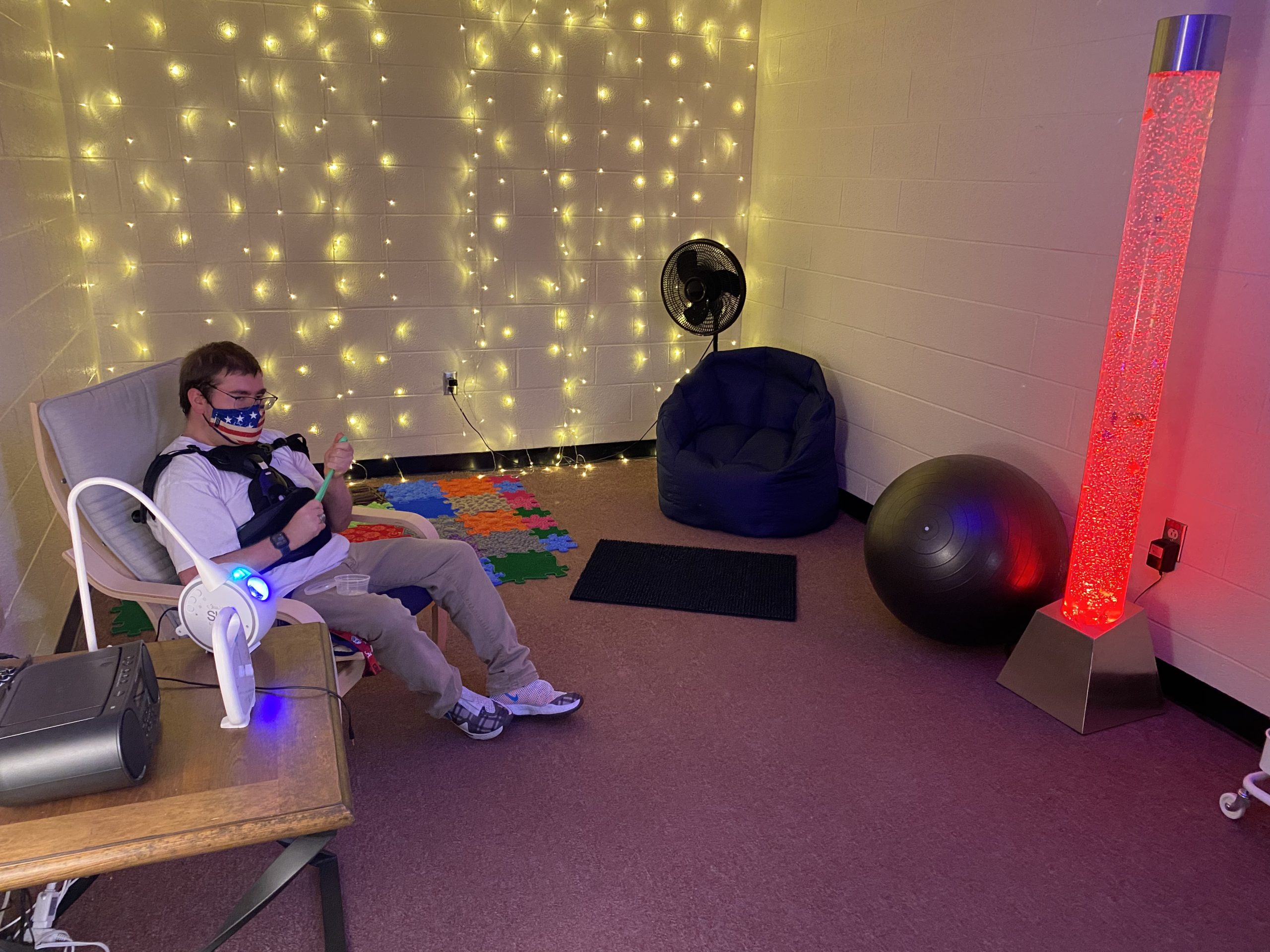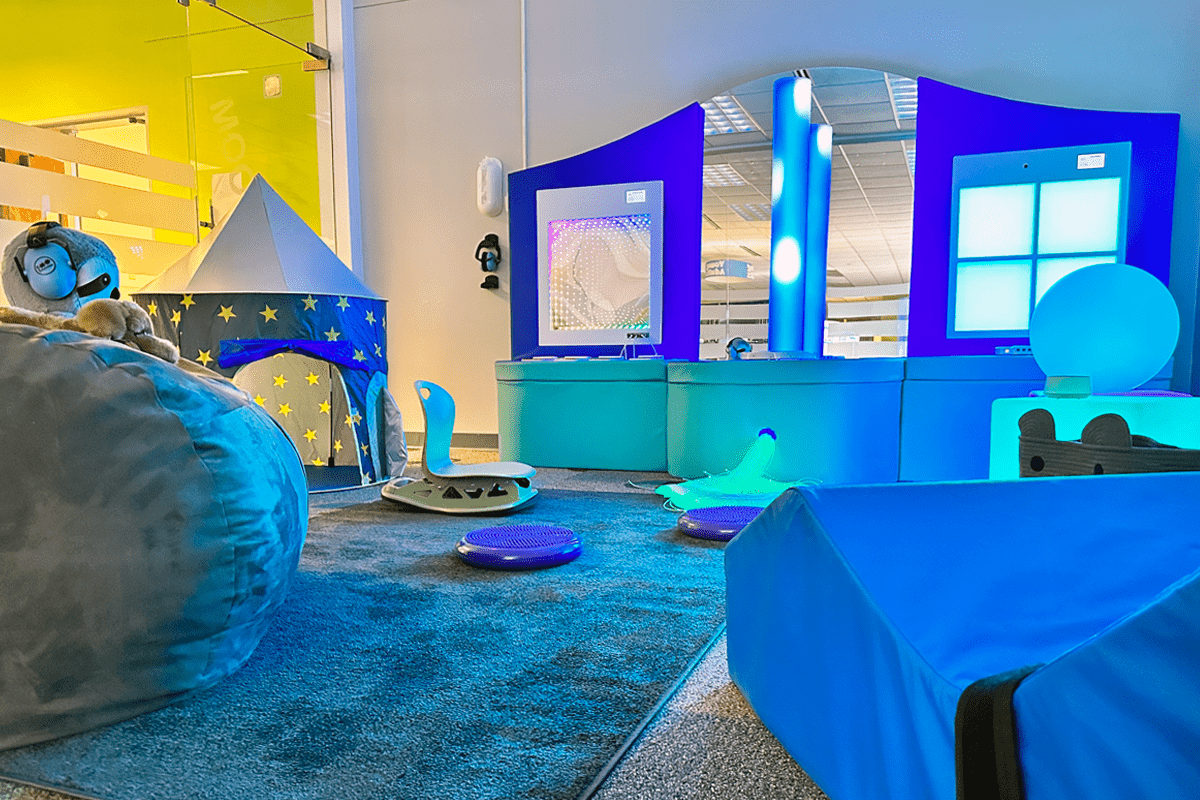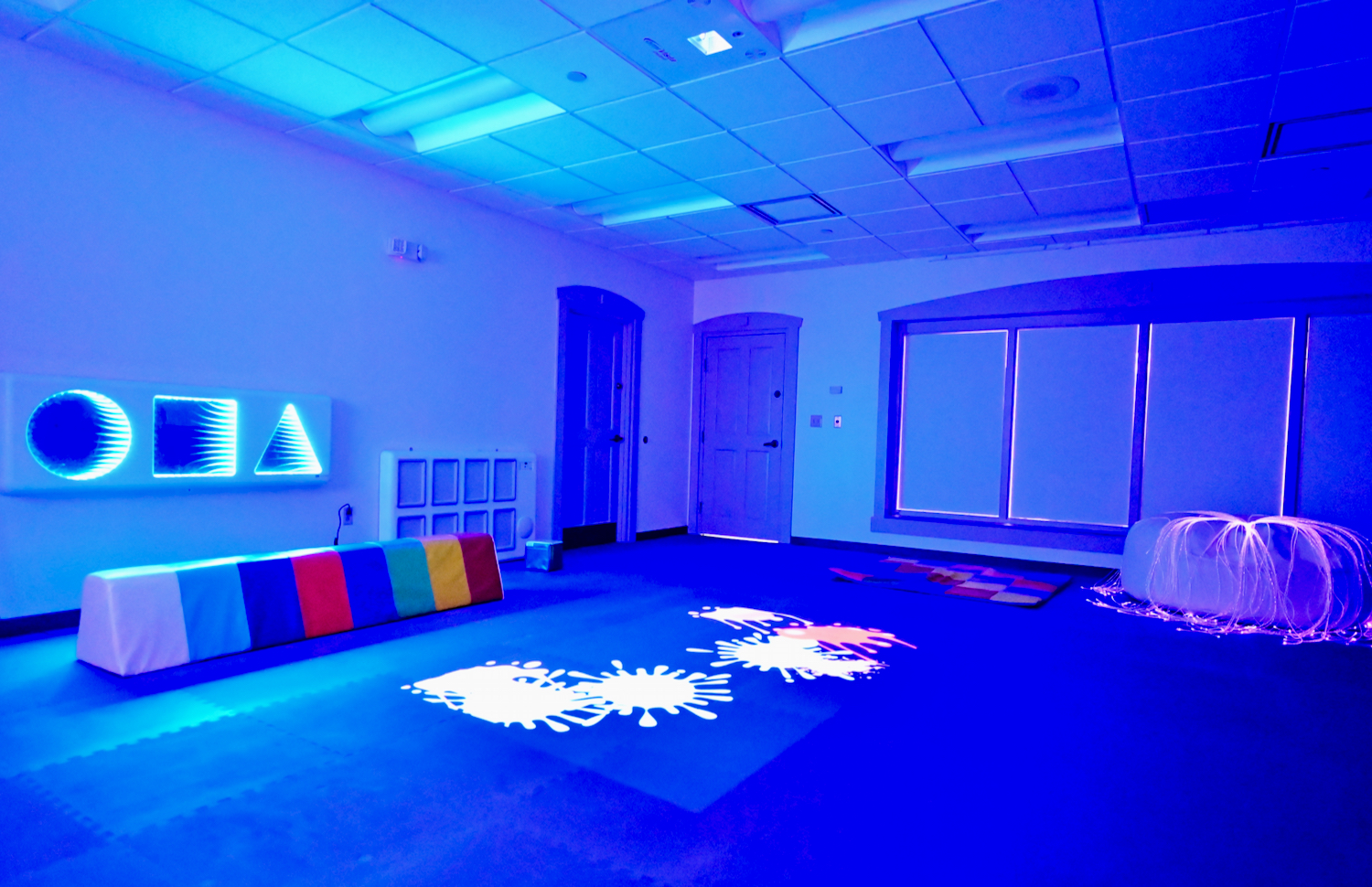Innovation Strategy and Roadmap: Public Library Sensory Kits and Sensory Calming Room

Here’s the link to my Notebook LM podcast for a synopsis of the innovation strategy and roadmap:
https://drive.google.com/file/d/1xMb5gSHHNr4HjdXNVSqZYpm9DUCsMhoY/view?usp=drive_link
«Action Brief»
Convince the Ronald H. Roberts Temecula Public Library that by adding a sensory calming room and sensory kits available in the library they will give all children with special needs and their families the ability to have access to needed sensory input via the kits and multi-sensory room which will create equity, diversity, and the ability for the patrons to self-regulate because providing sensory-based stimuli to special needs patrons helps them reduce stress, participate and engage in surroundings, and be an inclusive and active member of the community.
⇓
⇓
“Bad libraries build collections. Good libraries build services. Great libraries build communities.”
(Lankes, n.d.).
«Ding! Ding! Ding! The IDEA»

To add sensory kits and a sensory calming room to the Ronald H. Roberts Temecula Public Library.
The Ronald H. Roberts Temecula Public Library has been labeled as “the busiest library in the Riverside County Library System” (Branch histories, n.d.). The library occupies 34,000 square feet and, with that space in mind, the goal is to add a multi-sensory room along with having the ability for patrons to check out sensory kits.
Sensory kits can include a weighted lap pad, fidget spinners, squish balls, noise cancelling headphones, pop-its, and self-massagers. All items that get returned will be cleaned and sanitized before being checked out again along with having some other sensory items for replenishment purposes.
The sensory room would contain a bubble wall, weighted lap pads and stuffed animals, large bean bags, textured fidgets, stereo speaker, projector with projection wheels, fiber optic cable lighting, and more. The room would be available during regular library hours and would not require a reservation or library card to use the space. Supervision would be required for anyone under the age of 15.
The Ronald H. Roberts Temecula Public Library can partner with the Southwest California Autism Task Force to provide sensory resources to families of Temecula.
«Who Will You Help?»
⇓
⇓
Individuals with ASD and ADHD, developmental disabilities, and sensory processing impairments
According to statistics found on KidsData, in the Temecula Valley Unified School District, 2.6% of children aged 0-17 have difficulties in cognitive ability, self-care, hearing, and vision (KidsData, 2022).
The Centers for Disease Control and Prevention reported that California estimates that 1 in 22 (4.5%) of children are diagnosed with ASD (UC San Diego, 2023).
In a study conducted by Clement et. al, participants expressed the need to have a calm, quiet place to go to:
“But if I’m in a quiet room, getting ready, and I tell myself, ‘Listen, I’m going to be faced with sounds,’ that ‘I’m going to be faced with smells,’ and I mentally prepare myself beforehand. Then, you know, it’ll be more effective” (2022).
Also, having a calming room to help recover from anxieties and meltdowns is important for people with disabilities:
“If there was an opportunity to have a room that I could sit there, even if it’s just a tiny room where I could close the door and be by myself and it would drown out the sound a little bit” (2022).
Along with providing a safe, calm sensory room for the community, the library has the ability to give families and individuals sensory kits to use for assisting in self-regulation. The materials provided in the kits will help people refocus their thoughts along with reducing stress and anxiety.
“Playing with several types of sensory toys help to stimulate the five senses (touch, smell, taste, sight, and hearing), providing sensory input, which is necessary for the brain to process information” (Welch, n.d.).
«Examples of Sensory Kits at Libraries»


«Examples of Sensory Calming Rooms at Libraries»


«Inspiration»
Links:
Dakota County Library (MN) presentation PDF: https://www.scls.info/sites/www.scls.info/files/documents/file-sets/116/grassimadisonpresentationpacket.pdf
Ocean County Library’s Sensory Space: https://programminglibrarian.org/articles/place-comfort-and-calm-creating-sensory-space-inside-library
Penn State University Libraries: https://www.psu.edu/news/university-libraries/story/libraries-piloting-sensory-rooms-supportive-spaces-neurodiverse-students
Owatonna Public Library: https://www.owatonna.gov/CivicAlerts.aspx?AID=1075
NYU Libraries: https://www.nyu.edu/about/news-publications/news/2023/october/N-38.html
The PDF from the Dakota County Library outlines various sensory-friendly programs, inclusive program strategies, and inclusive spaces to help accommodate neurodivergent individuals navigating the library space. The PDF is chalk full of useful information regarding sensory-friendly approaches to individuals with ASD.
In New Jersey, the Ocean County Library found inspiration to create a sensory space through, of all things, the Real Housewives of New Jersey. When a parent on the show described getting kicked out of a public library because of her autistic child’s meltdown, Ocean County felt the need to create a space where ALL are welcome. Per the Programming Librarian article, families expressed their appreciation for the space: “they would’ve had to cut their outings short and go home if it wasn’t for the space to regroup” (Arata, 2022).
Statistics have shown that about 39% of students with autism graduate from college compared to 52% of neurotypicals, with sensory challenges playing a role in lower graduation rates (Penn State, 2023). Pen State University incorporated three sensory rooms across their libraries since neurodivergent students are a growing demographic and studies show that these spaces can help reduce anxieties and stress without judgement. Some accommodations found in the sensory rooms include floor cushions, dimmable lighting, puzzles, coloring supplies, and noise-canceling headphones.
The Owatonna Public Library saw a need for helping users with sensory processing challenges feel included and welcome in the library setting (City of Owatonna, 2024). Through the Diversity, Equity, & Inclusion Grant, librarians were able to kickstart the sensory kits initiative. The sensory kits included items such as sunglasses, headphones, fidgets and visuals, and weighted lap pads.
In collaboration with NYU’s Moses Center for Student Accessibility and NYU’s Disability, Inclusion, and Accessibility Provostial Working Group, the first floor in the Bobst Library has a low-sensory space for students that is outfitted with a sensory pod, bean bag pillows, yoga mats, adjustable lighting, and noise-cancelling wall paneling (NYU, 2023). The article goes on to discuss incorporating more sensory friendly environments for students since the need has grown due to more neurodiverse students enrolling in higher education and more openness about discussing mental health across campuses. The library’s role in providing a space for students to help reduce anxieties and stress along with giving the community low-sensory input to increase focus is pivotal to supporting equal access and necessary support for those in need.
«Sensory Calming Room Policies and Guidelines»
These policies are inspired by the Dakota’s Galaxie Library and Durham County Library’s approach to the sensory room:
- No library card or reservation is needed
- Supervision required for anyone under the age of 15 or if necessary for safety
- Room is to be used for sensory soothing as needed
- Individuals can stay as long as necessary to re-regulate
- Everyone has an equal opportunity to use this space from children to adults
- Cost recovery fees will not be be charged
- Keep all supports in the room
- Please ask library staff if you need assistance
- Let library staff know if anything is broken or not working
- Food and drink for medical/dietary needs allowed in room
«Sensory Kit Policies and Guidelines»
- Sensory kits can be checked out for two weeks
- Can be renewed up to 3 times
- Cost recovery fees will not be charged
- Let library staff know if anything is broken
«Timeline for Implementation»

Creating a sensory calming room for the Ronald H. Roberts Temecula Public Library will be large in scope and need the library staff team to effectively advocate and launch this service. The library team will need to be presented with the project’s breadth and be broken up into different task groups (marketing, partnering with communities, purchasing, policy making, and implementation). The small group aesthetic will help reduce the timeline for starting up the project and give each member an opportunity to come up with creative ideas for how to create a safe, calm, and welcoming space for users. Other similar-sized libraries will be contacted by the small task group to gain information regarding timelines, ideas for appropriate furnishings, and to fine-tune any ideas to fit the library’s information community. All ideas taken from the small group task force will be presented to pertinent administrators, the children’s services librarian, and the information services librarian to be approved or adjusted to begin the project. If the project gets denied, the focus of the plan can shift to investing in sensory kits, both available for library use as well as for check-out.
The preferred timeline for this project would involve:
1-2 months of research and planning including: initial research, identifying stakeholders, developing a budget, planning the space, and the proposal creation.
2-3 months of acquiring items and designing the space including obtaining approvals, completing design, ordering items, and hiring professionals.
1-2 months of construction and setup
1 month soft launch and staff training
If I were to hazard a tentative timeline for this project, I would guess this would take about 8 months to a year.
(Timeline ideas inspired by ChatGPT): (OpenAI, 2024).
«Marketing»

Planning Ideas:
- Newsletters and leaflets
- Social media
- Library main page
- Word of mouth
- Press release to newspapers, radio stations, television stations
- Contacting organizations in the area (Inland Regional Center, Southwest California Autism Task Force)
- Promotional items (bookmarks, pins)
(Planning ideas inspired by ALA’s Basic Promotion Guide): https://www.ala.org/tools/programming/adams/adamsssn15
«Staff Training»

Information shared with staff will be communicated through an easy-to-read internal library newsletter as opposed to sending out mass emails.
All library staff should have some level of neurodivergent awareness training, but children’s and YA librarians will need more in depth instruction to provide effective services to the community.
Through the joined efforts of the University of Washington Information School and the Institute of Museum and Library Services, the Autism-Ready Libraries Toolkit is an excellent source for free training and resources. Information found here will assist the YA and Children’s librarians in gaining effective strategies to help meet the autism community’s needs and thus train other staff who will be passing out sensory kits as well as offering assistance when necessary to the sensory calming room. Staff will be trained to check for damages and sanitize the sensory kits along with the sensory calming room when not in use. Also, training will include what items go into each kit as well as where furnishings/items belong in the sensory space.
The library can either close for a training day so that all staff are aware of the new policies and procedures associated with the sensory kits and room. After the training, follow up via internal library newsletter can be communicated to staff with pertinent information and the policies and procedures will be made available to the team.
«Evaluation and Assessment»
Benchmarks and Performance Metrics for Sensory Calming Room
- Track how many people are using the sensory room
- Track the average time people are using the sensory room
- Track when people are using the sensory room to see data for when it’s most and least occupied
- Get feedback from users
- Get feedback from staff
- Track what tools and technology are being used
Benchmarks and Performance Metrics for Sensory Kits
- Track how many people are checking out the kits
- Track how many people renew the kits
- Get feedback from users
- Get feedback from staff
- Track what items patrons are using to see what is being used vs. not used
Stories to Tell
Ideally, anonymous testimonials from families and users for both the sensory calming room and sensory kits will discuss the importance of having a safe, welcoming space for neurodivergent individuals to use without judgement or prejudice. The stories’ focus will be on creating spaces and toolkits for INCLUSION; the library is for ALL people and creates equal and inclusive learning opportunities within a safe space.
Expansion
In addition to a sensory calming room, there could also be a multi-sensory room focused on sensory input. This would be for individuals to stimulate their five senses while engaging and interacting with items. The calming room could also be incorporated to other local libraries who see the benefits of the service. Sensory kits could expand to include more stimuli and being put into different categories (children, teens, adults) for different user’s needs.
References
ALA. (n.d.). Basic promotion guide. https://www.ala.org/tools/programming/adams/adamsssn15
Alkurhah. (2015, January 16). Sensory overload. [Video]. YouTube. https://youtu.be/K2P4Ed6G3gw
Arata, H. (2022). A place of comfort and calm: creating a sensory space inside the library. https://programminglibrarian.org/articles/place-comfort-and-calm-creating-sensory-space-inside-library
City of Owatonna. (2024). OPL sensory kits. https://www.owatonna.gov/CivicAlerts.aspx?AID=1075
Clement, M.A., Lee, K., Park, M., Sinn, A., & Miyake, N. (2022). The need for sensory-friendly “zones”: learning from youth on the autism spectrum, their families, and autistic mentors using a participatory approach. Frontiers in Psychology, 13. https://doi.org/10.3389/fpsyg.2022.883331
Dakota County Library. (n.d.). Calming space social narrative. https://www.co.dakota.mn.us/libraries/Programs/Everyone/Documents/CalmingSpaceSocialNarrative.pdf
Durham County Library. (2023). Main library sensory room policy. https://durhamcountylibrary.org/policies/sensory-room-policy/
Grassi, R. (n.d.). Creating sensory-friendly experiences for youth with Autism Spectrum Disorder. https://www.scls.info/sites/www.scls.info/files/documents/file-sets/116/grassimadisonpresentationpacket.pdf
KidsData. (2022). Children with major disabilities (regions of 10,000 residents or more). https://www.kidsdata.org/topic/770/disabilities-10k/Bar#fmt=1178&loc=1106,367&tf=156&sort=loc
Librarianship Studies & Information Technology. (n.d.). Best quotes about libraries librarians and library and information science. https://www.librarianshipstudies.com/2018/05/quotes-libraries-librarians-library-information-science.html
NYU. (2023). NYU libraries opens low-sensory room for neurodiverse students and others who benefit from a calming environment. https://www.nyu.edu/about/news-publications/news/2023/october/N-38.html
OpenAI. (2024). ChatGPT. (GPT-4) [Large language model].
Penn State. (2023). Libraries piloting sensory rooms as supportive spaces for neurodiverse students. https://www.psu.edu/news/university-libraries/story/libraries-piloting-sensory-rooms-supportive-spaces-neurodiverse-students
Riverside County Library System. (n.d.). Branch histories. https://rivlib.net/branch-histories
UC San Diego. (2023, March 23.) Autism rates continue to rise in California. https://today.ucsd.edu/story/autism-rates-continue-to-rise-in-california
University of Washington. (n.d.). Autism-ready libraries toolkit. https://sites.uw.edu/neurodiversity/research-projects/autism-ready-libraries/toolkit/
Welch, H. (n.d.). The benefits of sensory toys for children with autism. https://www.thegeniusofplay.org/genius/expert-advice/articles/the-benefits-of-sensory-toys-for-children-with-autism.aspx
4 Comments
P. Fulumirani
Hi Claire,
Thank you for sharing, this such a great and well-thought out idea. We get various adult special needs groups come in throughout the week at my local library and this would be a wonderful resource for them (and also the library system overall).
Millicent
@claireburke I actually didn’t know about sensory rooms and kits in more detail, until recently. I actually went into a sensory room, and I instantly felt relief. My anxiety has been out of this world lately, and I started to feel burnt out, and the sensory room honestly gave me life again. It allowed me to reboot and “work again”. I think this idea is so beneficial and thoughtful, and would get great use!
Arthur Kolat
@claireburke Sensory rooms and kits are a great idea. This reminds me of an art installation I once saw in NYC: LaMonte Young’s Dreamhouse, which is a continuous sound environment with sine wave drones that never stop playing! It’s a highly controlled environment that changes sensory perception and even invites a kind of meditative experience. I’m not saying that it’s exactly right for a library, but it is an interesting conceptual art piece that promotes the exploration of controlled sensory environments and the perceptual effect of continuous sound. You say that the sensory room would contain a speaker. I wonder what kinds of sounds people are interested in exploring! Cheers! — Arthur
https://en.wikipedia.org/wiki/Dream_House_(installation)
Valancy
@claireburke this is a great project! Also, it’s a great cause that I wish we could actually launch at my library. I did a WebJunction “Helping librarians to be autism-ready” toolkit this summer in preparation for working with ASD children at my library. I can see the thought and research you put into your plan: everything you included aligned with what was in the toolkit!